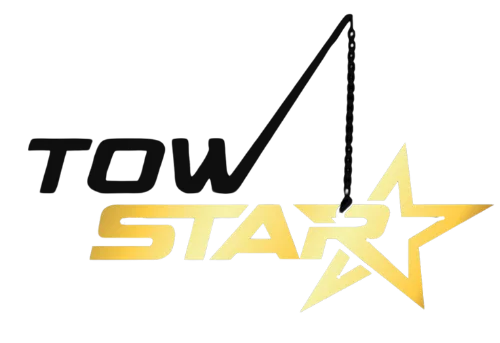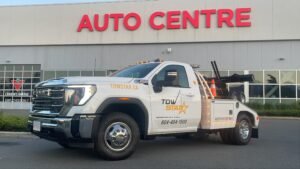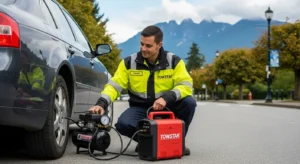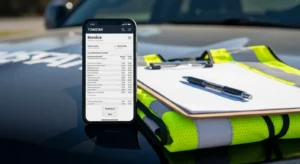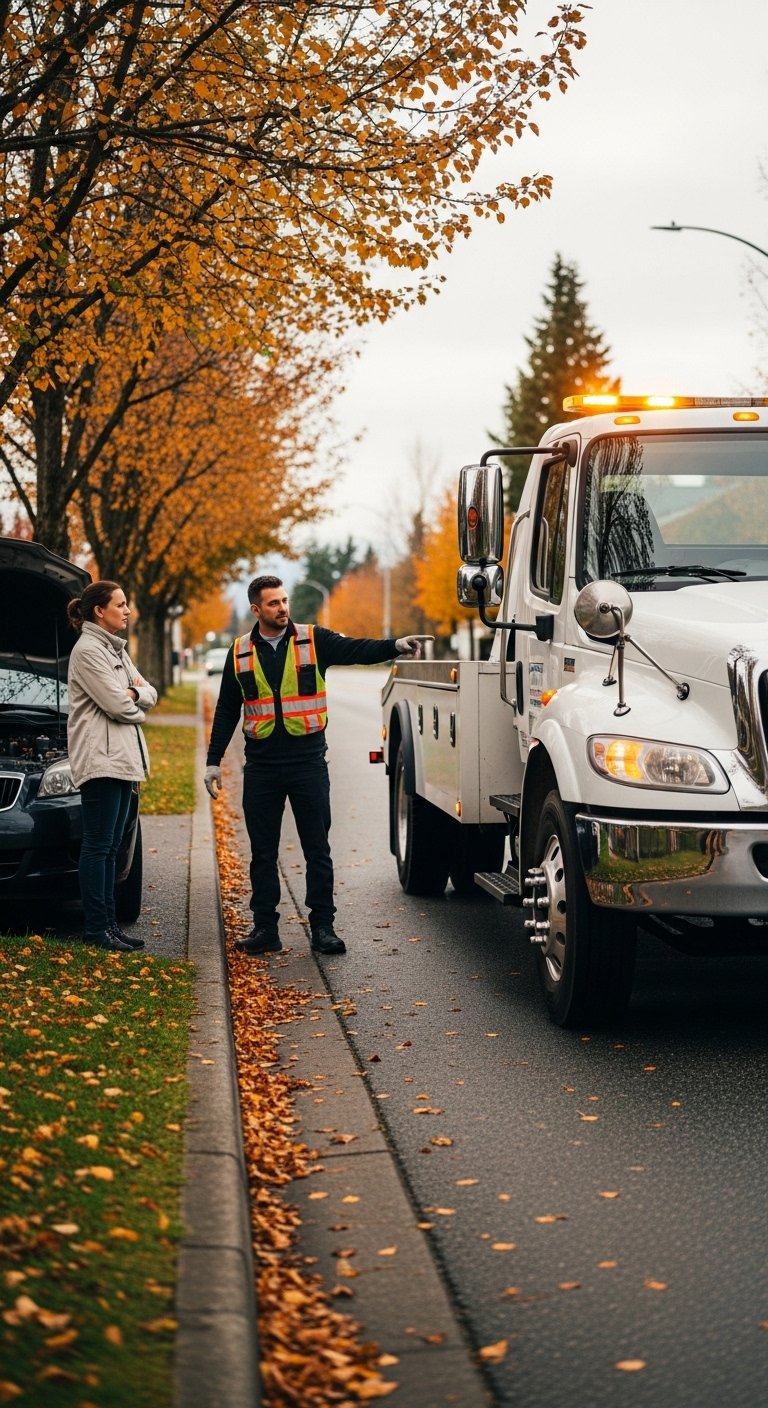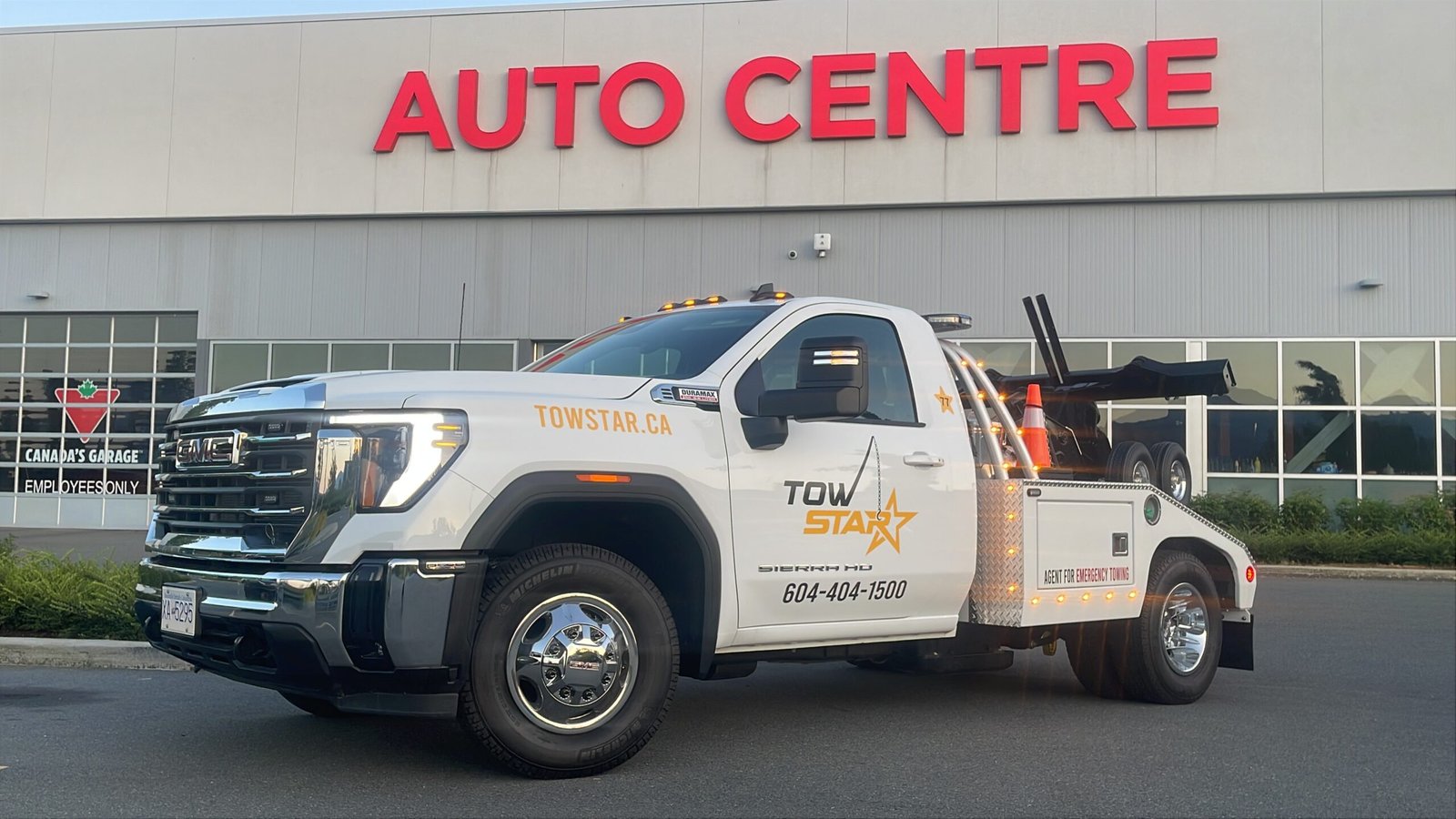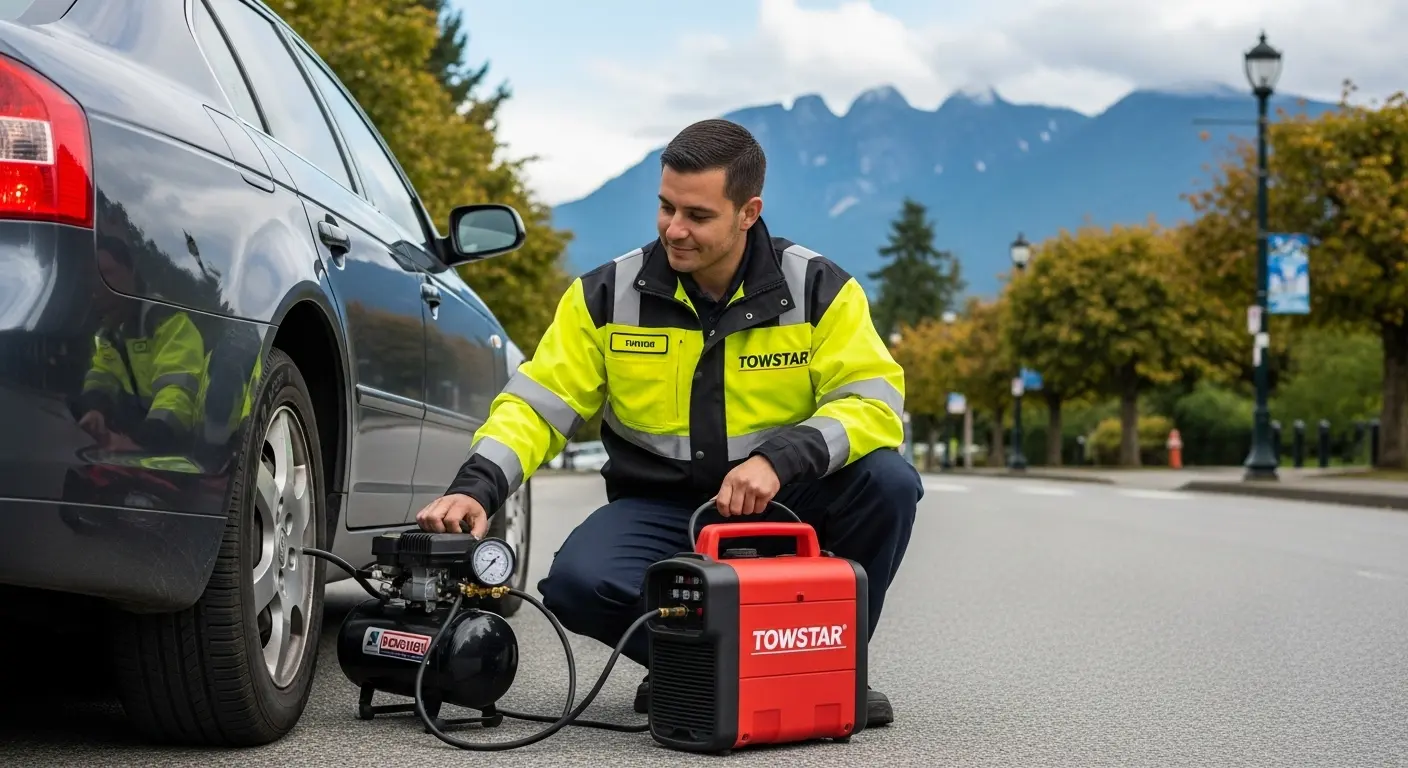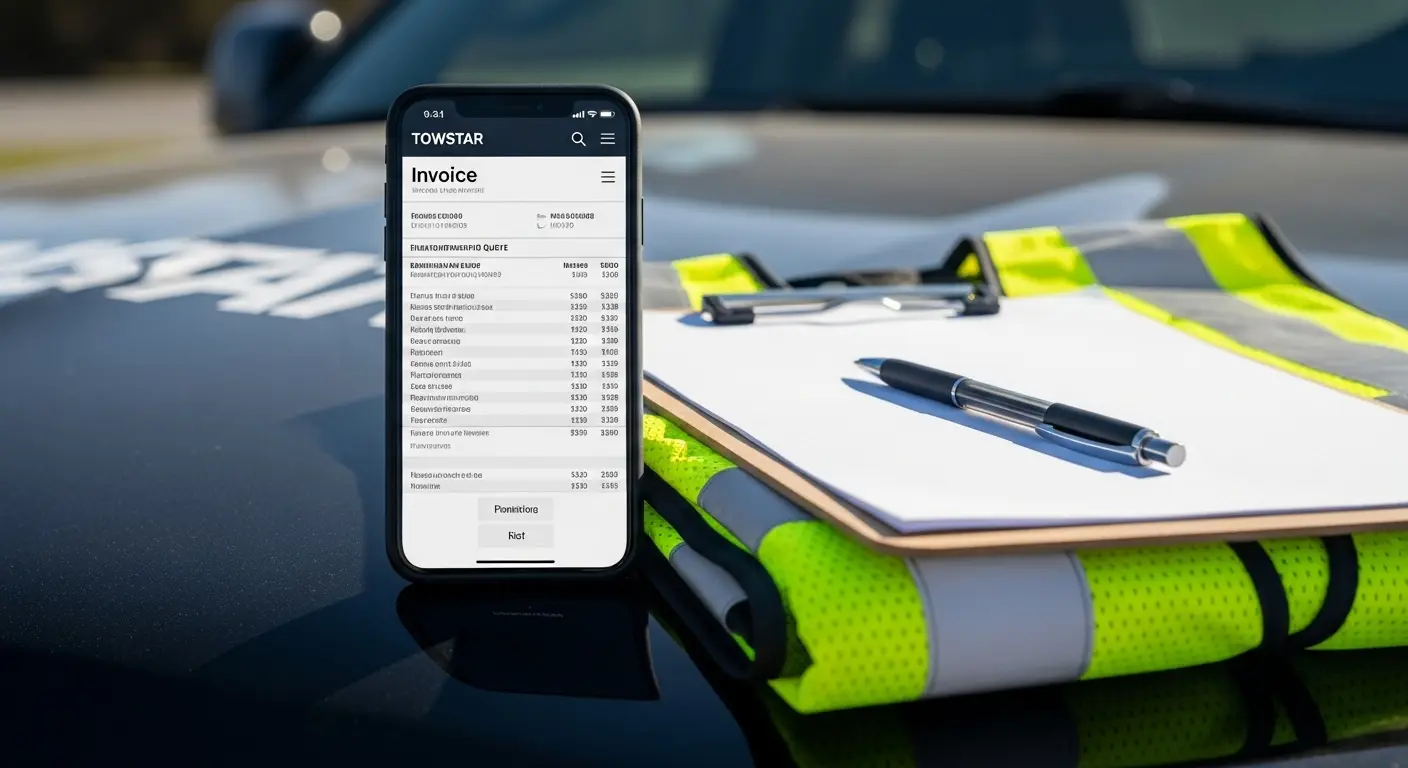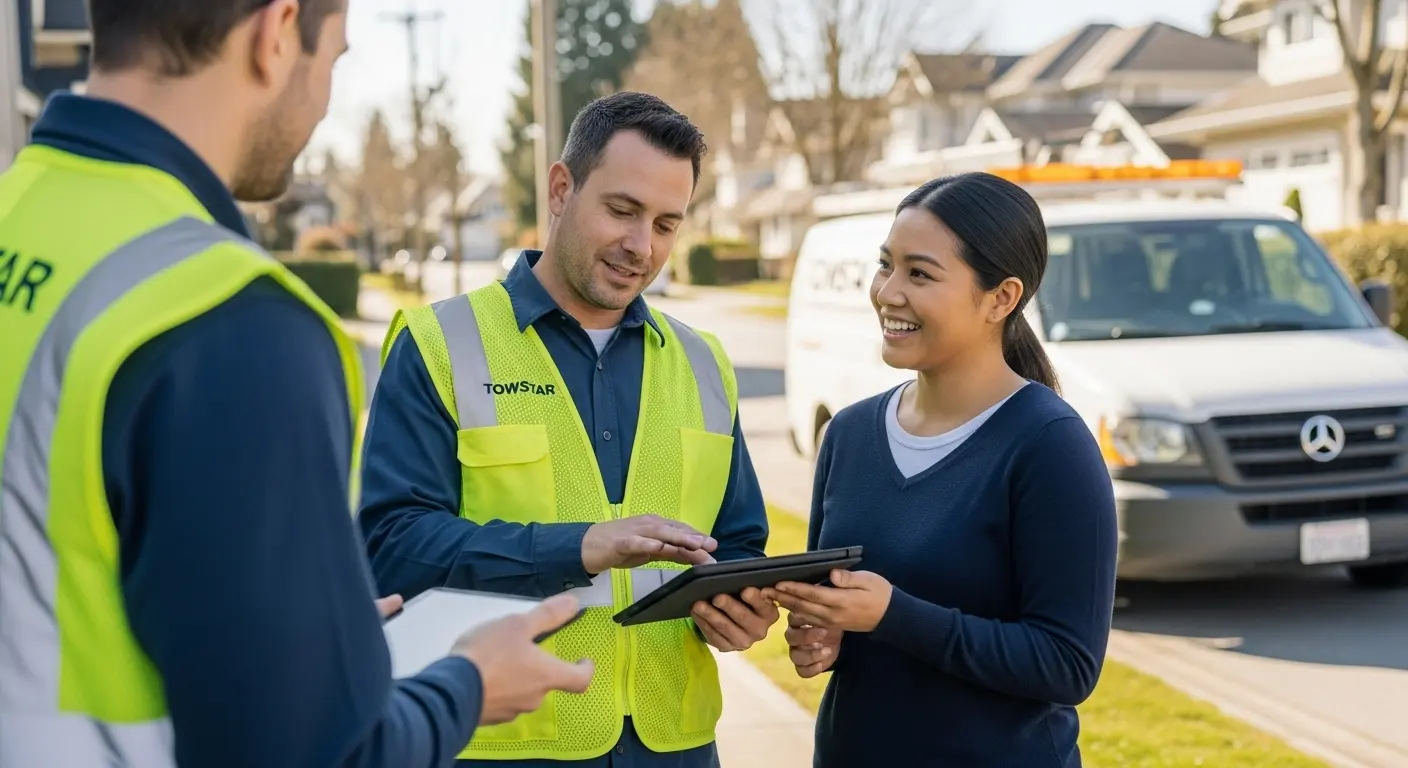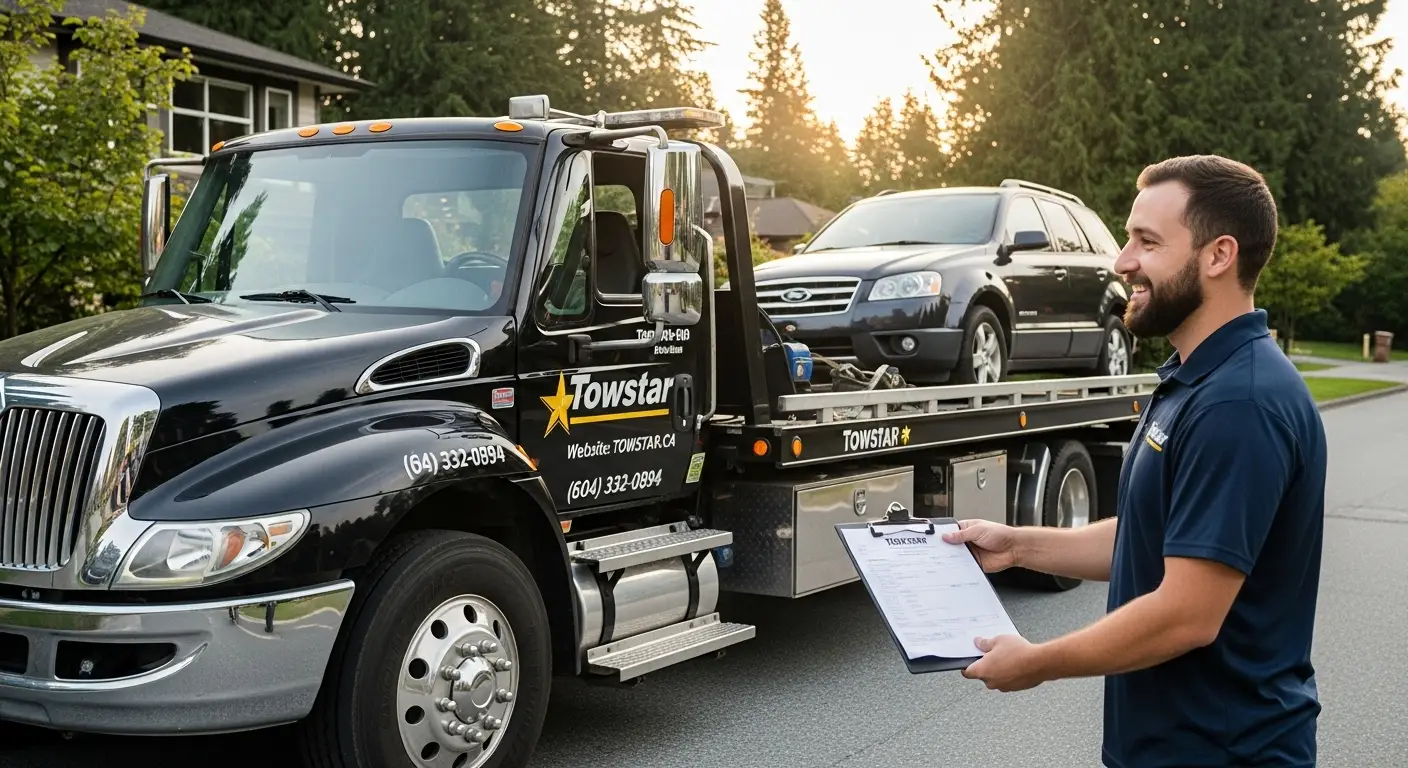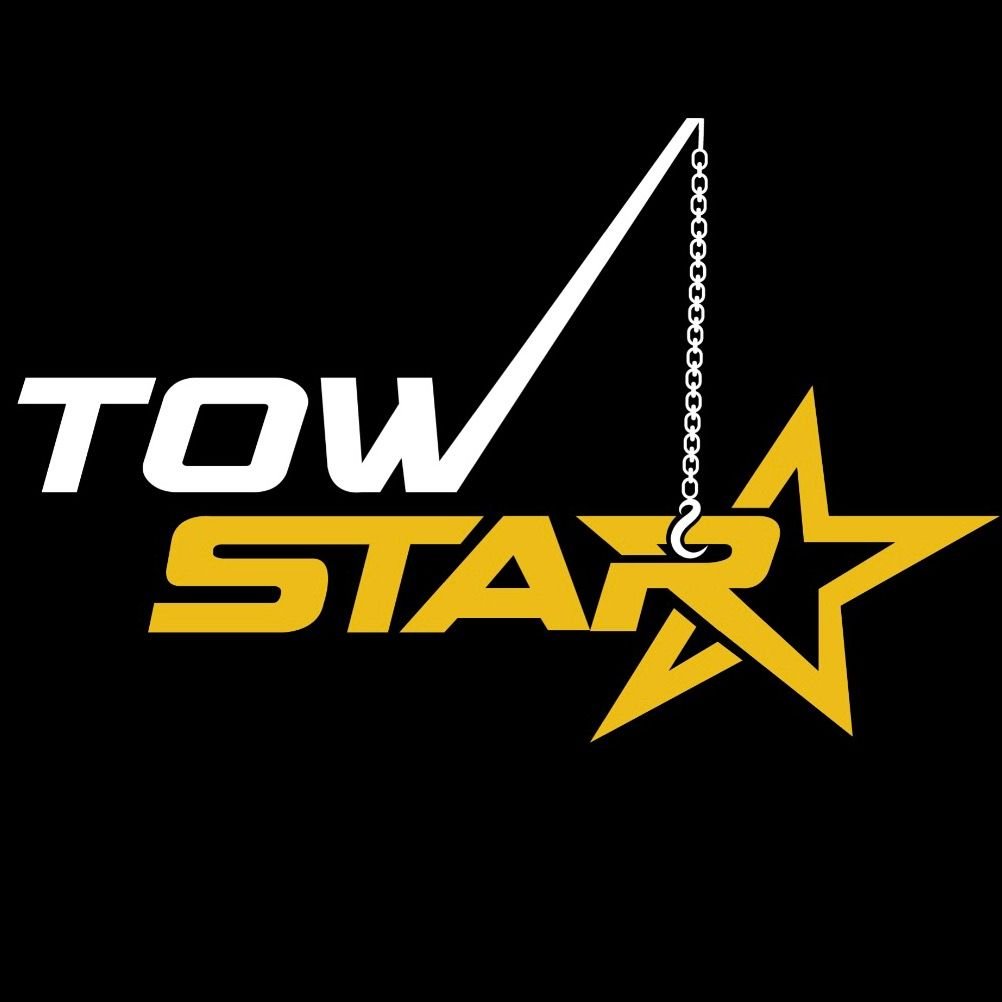Imagine your Ram 3500 stuck on a snowy Trans-Canada Highway slope. It can haul 36,610 pounds, but now it’s useless. Or picture your Rivian R1T, with its 11,000-pound electric muscle, slipping off an icy logging road near Whistler. When heavy-duty towing services in BC are your only hope, you need real power, not just hope.
The 2025 Ram 3500 has a Cummins diesel engine with 1,075 lb-ft of torque. This is enough to pull a school bus out of a ditch in a Saskatchewan blizzard. Electric heavy haulers like Rivian also offer smart towing systems for mountain rescues. But how do you know when a regular tow truck won’t do?
Key Takeaways
- New diesel trucks offer 20% more torque than 2020 models for extreme recoveries
- Electric heavy haulers provide instant power but require specialized charging access
- Integrated systems automatically adjust for loads up to 80,000 pounds
- Canadian winters demand equipment rated for -40°C operation
- Always verify provincial weight certifications before booking
Rescuing a stuck motorhome near Banff or recovering construction equipment in Ontario’s cottage country requires the right hauler. Choosing the right one is key. “Good enough” isn’t an option when temperatures drop and deadlines are near.
Understanding Modern Heavy Haulers
Today’s heavy-duty recovery vehicles are more than just strong machines. They are equipped with advanced technology to solve problems. Imagine a tow truck that remembers your last recovery angle or adjusts hydraulic pressure for icy roads. These modern marvels are your safest choice when things go wrong.
What Makes 2025 Models Different?
2025 wrecker trucks have upgrades that will make your old rig look outdated. The new ZF Powerline 8-speed transmission can handle over 1 million lb-miles between services. That’s like driving from Toronto to Vancouver 38 times with a full load! Plus, the 14.5″ Uconnect dash screens provide real-time diagnostics as clear as your smartphone.
Three key features you’ll love:
- Auto-tensioning winches that prevent cable slippage
- Smart stabilizers that map ground density
- Collision-avoidance systems for tight recovery zones
Key Components of Heavy Wreckers
The heart of every heavy hauler is its core parts. The telescoping boom is not just steel; it’s triple-layered alloy that bends without breaking. Your underlift becomes a precision tool with pressure sensors that warn about fragile frames before you hook up.
Essential elements for safe recoveries:
- 360° LED light towers with fog-piercing modes
- Dual-circuit air brakes that engage in 0.8 seconds
- Modular storage for chains/binders within arm’s reach
Sign 1: Your Load Exceeds 10,000 lbs
That “compact” excavator you’re hauling? With its trailer, it could easily hit 14,000 lbs – way beyond what light-duty trucks handle. This is where commercial towing specialists step in. Let’s break down why weight matters and how to stay compliant.
When Light-Duty Systems Fail
Standard tow trucks max out at 10,000 lbs. Push past that limit, and you’ll risk:
- Bent frames from uneven weight distribution
- Overheated transmissions on hills
- Brake failure during sudden stops
New heavy-duty models like the Ford F-350 handle up to 27,000 lbs. But capacity isn’t just about the truck – it’s about the entire recovery system.
Calculating Combined Weight
Always check your Gross Combined Weight Rating (GCWR). Here’s a quick guide:
| Vehicle | Weight | Trailer | Total |
|---|---|---|---|
| Silverado 3500HD | 7,500 lbs | 12,000 lbs | 19,500 lbs |
| Ram 3500 | 8,200 lbs | 14,000 lbs | 22,200 lbs |
Pro tip: Add 15% as a safety buffer. Mountain routes? Make it 20%.
Provincial Weight Regulations
Canadian rules vary by region:
- Alberta: 20% capacity buffer on mountain highways
- Ontario: Mandatory weigh station stops >8,500 kg
- BC: Special permits needed for loads wider than 2.6m
Heavy duty vehicle recovery teams carry certified scales and know local laws cold. Don’t guess – measure twice, tow once.
Sign 2: Specialized Equipment Transport
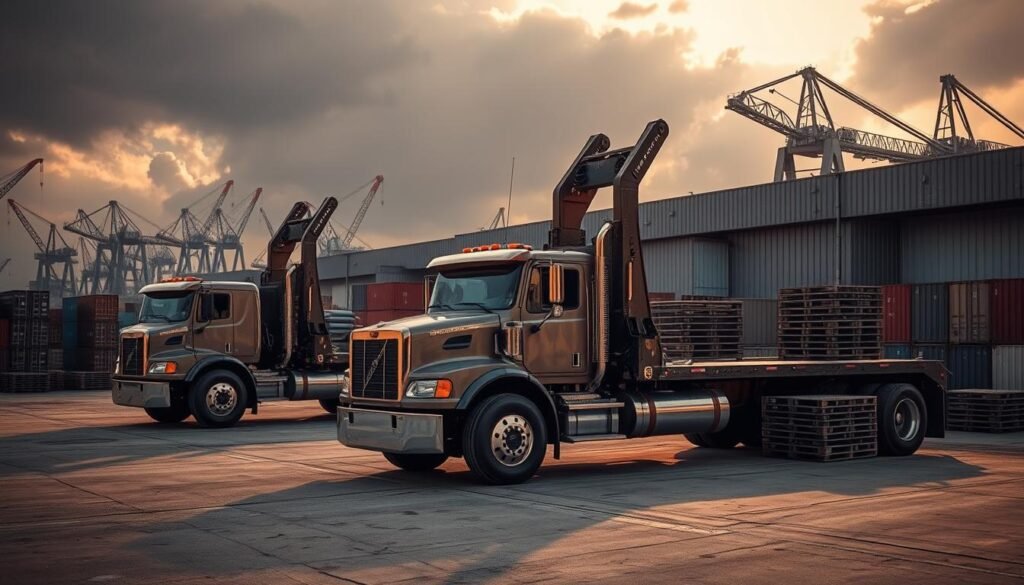
Transporting heavy machinery is different from moving a couch. It requires careful handling of construction equipment and industrial tools. Flatbed tow trucks and heavy wrecker trucks are perfect for this job. They can handle big, awkward, and delicate items.
Protecting Construction Machinery
Modern equipment needs careful handling during transport. The 2025 Chevy 2500HD’s gooseneck system uses laser-guided positioning. It safely holds excavator buckets and bulldozer blades.
Three important features help protect the equipment:
- Rubberized deck coatings prevent metal-on-metal scratches
- Retractable side rails lock equipment in place
- Load sensors alert drivers to shifting weight
Securing Oversized Loads
That 12-foot-wide mobile crane? New Ram 5500 chassis cabs use military-grade straps and hydraulic tensioners. Here are the details:
| Model | Max Width | Strap Capacity |
|---|---|---|
| Standard Flatbed | 8.5 ft | 5,000 lbs |
| 2025 Extended | 12 ft | 8,200 lbs |
Bridge Clearance Challenges
Toronto’s Gardiner Expressway has 53 low bridges – a big challenge for tall loads. Heavy wrecker trucks now have updated routing software. It includes:
- Real-time height measurement using roof lasers
- 3D mapping of provincial overpasses
- Alternate route suggestions every 2 km
Remember, always add 6 inches to your measured height for safety. Those “Maximum Clearance” signs are not just suggestions!
Sign 3: Off-Road Recovery Needs
Imagine your dump truck’s rear axle sinking into a Northern Ontario peat bog at -30°C. Light-duty tow trucks would freeze faster than maple syrup in January. This is when rotator tow trucks become your recovery superheroes. They have industrial-strength winches and military-grade stabilization.
Winch Capacity Requirements
Not all winches are built for Canadian winters. Basic models struggle with frozen cables. Heavy-duty systems use PTO-driven hydraulics that work even when icicles form.
The Ram Power Wagon’s 12,000-lb winch is impressive for pickups. But you’ll need 50-ton capacity for sinking tractors. Key specs to check:
- Double-line pull strength (minimum 2x vehicle weight)
- Cold-rated synthetic rope vs steel cable
- Dual-speed controls for precision recovery
| Feature | PTO-Driven Winch | Electric Winch |
|---|---|---|
| -40°C Performance | No battery drain | Risk of failure |
| Max Capacity | Up to 100 tons | Usually under 20 tons |
| Maintenance | Hydraulic fluid checks | Battery replacements |
Stabilization on Uneven Ground
Muddy slopes demand more than outriggers. Modern integrated towing systems use laser-level sensors and automatic weight distribution. We’ve seen trucks tilt 22° on BC logging roads without tipping – thanks to triple-lock stabilizers and floating axle designs. Always verify:
- Ground penetration pads (minimum 18” diameter)
- Independent leg controls
- Real-time load monitoring displays
Environmental Protection
Recovering vehicles shouldn’t mean destroying wetlands. Top operators use spill-containment mats and biodegradable hydraulic fluids. In sensitive areas like Alberta’s boreal forest, they’ll even deploy ground protection mats made from recycled tires. Remember:
- Provincial fines for fluid leaks start at $15,000
- Always request EPA-compliant equipment
- Ask about low-ground-pressure tire options
Sign 4: Hazardous Material Transport
Need to move dangerous goods? Forget about your regular tow truck. You need heavy-duty gear and certified pros for fuel, chemicals, or other risky stuff. Let’s look at why these jobs are special – and why you can’t take shortcuts.
Certification Requirements
Just any tow truck won’t do for hazardous materials. Transport Canada has strict rules:
- Class 3 driver certification with dangerous goods endorsement
- Spark-proof exhaust systems (standard on 2025 Ram 3500 models)
- Dual braking systems for controlled stops
Trucks like the GMC Sierra 3500HD come ready. But you need more than just a piece of paper. Your truck must match the cargo’s danger level.
Secondary Containment
Spills are inevitable, not optional. Good recovery units have:
- Spill pallets under fuel tankers
- Double-walled containment on chemical trailers
- Quick-seal valves that activate during separation
Modern setups can hold 110% of tank capacity. This is key for big loads like the Ram 3500. Remember, fines for spills are steep.
Emergency Protocols
When trouble hits, you need a plan:
- Contain the area using onboard barrier systems
- Communicate using MURS radios (cell service isn’t reliable)
- Deploy neutralization kits for specific chemicals
Great operators practice monthly. They use simulators. In Canada’s cold or on busy highways, you can’t afford to hesitate.
Sign 5: Multi-Vehicle Accidents
When five trucks and a sedan crash on Highway 401, regular tow trucks watch from the sidelines. Modern recovery vehicles bring military precision to these messy scenes. They have the power to pull with 3:1 strength, stay stable with quad-outriggers, and use integrated towing systems that control multiple winches. They also stream live footage to emergency teams.
Simultaneous Recovery
Imagine three SUVs stacked like pancakes in a winter crash. 2025 models use winches that pull vehicles apart safely. The Ram 2500’s trailer camera system lets operators check tension levels at four points at once. Ford’s 360° cameras create 3D maps of the wreck zone, helping to pull vehicles out safely.
Traffic Management
Your tow truck becomes the command center during big accidents. Advanced models have:
- Retractable LED message boards to divert traffic
- Diesel-powered light towers for night work
- Two-way radios that link to police scanners
These features help clear lanes quickly and keep responders safe. Some provinces now need accident management plans before giving out heavy wrecker licenses.
Debris Containment
Oil spills, broken glass, and scattered cargo are common in accidents. Modern carriers handle messes with:
- Magnetic sweepers for metal pieces
- Spill-proof fluid recovery tanks
- Fold-out containment berms
Ontario’s new rules require 90% of debris to be contained within 30 minutes. That’s why top operators use vacuum-sealed storage to keep hazardous materials in during transport.
Maintenance for Extreme Service
What makes a heavy hauler reliable? It’s the maintenance that can withstand punishment, not just the miles. Let’s look at three key areas for extra care.
Diesel vs Electric Powertrains
Heavy haulers come in two types: diesel and electric. Diesel engines, like Cummins’, last up to 500K miles but need regular oil changes. Electric models, such as Rivian’s, don’t have exhaust but need thermal checks.
| Feature | Diesel | Electric |
|---|---|---|
| Common Parts | Turbochargers, injectors | Battery packs, cooling lines |
| Service Cost | Lower per repair | Higher per component |
| Downtime Risk | Gradual wear | Sudden system faults |
Frame Inspection Points
Your wrecker truck’s frame faces tough forces. Monthly inspections should check:
- Boom connection welds
- Outrigger pad stress fractures
- Fifth wheel mounting points
Rotator models need boom wear sensors. These alert you before metal fatigue becomes a problem.
Hydraulic Service Cycles
Hydraulics are your heavy hauler’s muscles. Unlike car brakes, they need:
- Fluid analysis every 200 hours
- Hose pressure testing quarterly
- Cylinder rebuilds at 10,000 cycles
Ignoring these can lead to leaks when lifting heavy loads. Not great in a -30°C Manitoba winter!
Proper maintenance makes your wrecker truck a reliable partner. When that midnight call comes, you’ll be ready – not regretful.
Operator Training Standards
Modern heavy-duty recovery needs more than just power. It requires operators with technical skills and sharp minds. In Canada, 70% of training hours must be in VR simulators for recovery vehicles certification. This is because new technologies like Ram’s trailer reverse steering and GM’s Super Cruise systems need precise control.
Certification Programs
Canadian provinces updated their requirements in 2025. Operators must complete:
- 150 hours of supervised field training
- Province-specific load securement exams
- Quarterly safety refreshers (Alberta/BC mandate VR modules)
Simulator Training
VR rigs let you practice in safe environments. Try reversing a 53-foot trailer in virtual ice storms with Ram’s active steering assist. Or test GM’s hands-free towing tech on mountain passes. These simulations help build muscle memory for real-world heavy duty vehicle recovery operations.
Mental Health Resources
You’re not just moving metal—you’re managing mini-crises daily. Trauma counseling is now part of certification in Ontario and Quebec. Programs include:
- 24/7 crisis hotlines for operators
- Debriefing sessions after complex recoveries
- Stress management workshops (required every 6 months)
Recovering jackknifed semis or overturned fuel tankers is tough. It’s not just physically demanding. Your mind needs maintenance too.
Cost Analysis: Ownership vs Contract

Should you own heavy-duty equipment or pay per use? Let’s look at the costs for commercial towing. Whether you manage municipal fleets or private heavy wrecker trucks, saving money is key.
Depreciation Factors
New trucks lose value quickly. A Ram 3500 starts at $48K but drops 20% in the first year. High-end rotators? That $300K machine could depreciate $45K annually. On the other hand, contract services mean no loss of asset value.
Insurance Premiums
Ownership comes with yearly bills. Heavy wrecker trucks average $12K in insurance. Contracted jobs? You pay $850 per call instead. For small operators, this heavy-duty towing cost structure reduces fixed expenses.
Emergency Response SLAs
Contracts ensure guaranteed response times. Municipal fleets need 24/7 availability – ownership gives control. Private operators? Pay-as-you-go avoids staffing costs but risks slower help during peak demand.
| Cost Factor | Ownership | Contract |
|---|---|---|
| Yearly Depreciation | $45,000 | $0 |
| Insurance | $12,000 | $850/call |
| Emergency Response | Full Control | SLA-bound |
Not sure what to choose? Municipal fleets break even after 5 years of ownership. Private operators often save 30% with contracts. Your choice depends on call volume and cash flow.
Future Tech Preview
The trucks of 2025 will amaze you with their advanced tech. They’ll mix top-notch engineering with green tech. Let’s look at three new features that could change how we handle tough recoveries.
Autonomous Recovery Drones
Imagine a drone flying ahead to check out accident scenes. Ram’s Atlantis architecture is already testing these drones. They map out the area and find dangers before you get there. The benefits are:
- Real-time obstacle detection in tight spaces
- Faster response times during highway pileups
- Reduced risk for ground crews in dangerous conditions
Hydrogen Fuel Cells
Future heavy haulers might switch to hydrogen power. Hydrogen engines give instant power and no emissions. They’re great for city recoveries. Here’s how they compare to diesel:
| Feature | Hydrogen | Diesel |
|---|---|---|
| Refuel Time | 8 minutes | 25 minutes |
| Range | 650 km | 800 km |
| CO2 Output | 0g/km | 1,500g/km |
Silverado’s Super Cruise tech works well with these green engines. You get the power without the pollution.
AI Damage Assessment
Assessing damage just got a lot faster. New towing systems use AI to:
- Scan vehicle damage in 360 degrees
- Calculate optimal lift points in seconds
- Predict load shifts during transport
This tech makes rotator tow trucks more efficient. No more worries about weight or stability.
Choosing Your 2025 Workhorse
Finding the perfect heavy duty tow truck means matching your needs with the latest tech. For Canadian users, three key factors make a truck a long-term partner, not just a quick fix.
Canadian Climate Considerations
Winters in Northern Ontario are harsh, requiring trucks that can start in -40°C. Ram’s 2025 models have improved block heaters, cutting warm-up times by 18 minutes. Ford now offers extended corrosion warranties for 10 years, covering undercarriage components.
It’s important to check if the undercoating is over 250 microns thick. This is essential for areas with lots of salt on the roads.
Parts Availability
When your truck breaks down, you can’t wait. Look for brands with 24/7 parts availability across Canada. Flatbed tow trucks with standard hydraulic fittings are quicker to repair than those needing custom parts.
Make sure service centers are within 150 km of your main routes. This ensures quick access to parts and service.
Resale Value
Diesel might not be the best choice for resale in 2025. Hybrid-electric models hold 12% more value after 5 years in Canada. They also meet strict environmental rules in cities.
Keep detailed maintenance records using blockchain logs. This proves your truck’s history and can increase its resale value.
The best truck balances today’s needs with tomorrow’s costs. Whether you’re hauling in Manitoba’s storms or managing accidents on the 401, your truck is your lifeline. Choose one that can handle every challenge.
FAQ
What makes 2025 heavy haulers different from previous models?
Modern heavy haulers are powerful and smart. They have transmissions that last a long time and clear dash displays. The Ram 3500’s updated Cummins diesel has 1,075 lb-ft torque. Electric options like Rivian are great for Canadian winters.
How do I calculate if my load requires a heavy duty tow truck?
First, add your vehicle’s curb weight, trailer, and cargo. If it’s over 10,000 lbs, you need a heavy-duty tow truck. Alberta’s mountain roads need a 20% buffer for safety.
What special features protect construction equipment during transport?
2025 flatbeds use laser-guided positioning and deck-width stabilizers. For Toronto, use height-aware routing to avoid bridge strikes. Also, follow width regulations for 12’-wide mobile cranes.
Which winch type works best for BC mud recoveries?
Rotator systems are best with 50-ton booms for 360° stability. Electric winches are precise, but PTO-driven systems are better in -40° winters. Always check hydraulic fluid ratings for your environment.
What certifications are needed for fuel tanker recovery?
Transport Canada requires Class 3 certifications with spark-proof exhausts and dual braking systems. Your rig must handle 110% of tank capacity to prevent spills during incidents in Ontario.
How do wreckers handle multi-vehicle accidents on the 401?
Modern systems use quad-outrigger stabilization and 3:1 pulling capacity. The best 2025 wreckers coordinate multiple winches and live-stream recovery ops to emergency crews. This is key for managing 6-car pileups safely.
Diesel or electric – which costs less to maintain?
Diesel is cheaper for parts but needs frequent hydraulic fluid analysis. Electric models need 40% fewer services but require specialized technicians. Consider your location’s repair infrastructure.
What training do modern tow operators need?
Canada requires 70% of training hours in VR simulators. This includes mountain recoveries and whiteout conditions. Updated certifications include trauma counseling training for severe accident scenes.
Is buying a 0K rotator truck worth it?
A> For municipal fleets: yes (5-year ROI). Private operators should compare K/year insurance vs 0/call contracts. Resale matters – diesel models retain 62% value after 8 years, while electric retains 78% in Canadian markets.
What future tech will change heavy towing?
Hydrogen-powered wreckers and AI systems will change heavy towing. Drones will scout accident sites, and augmented reality glasses will guide operators. This tech will make recoveries easier and safer.
Which 2025 model works best in Northern Ontario?
Look for block heater compatibility and undercoating durability. Electric models with self-heating batteries outperform diesel starters at -35°C. Always check parts availability – some tech has 6-week backorders in Thunder Bay.
